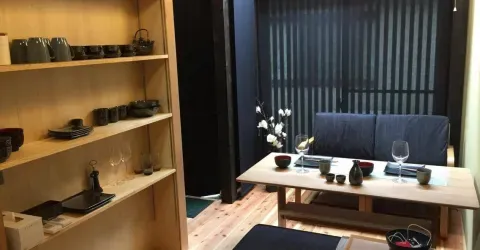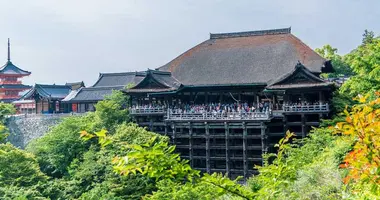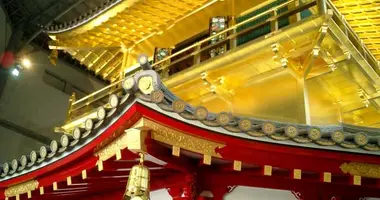Kibune - Kurama
Hiking Kibune to Kurama, Kyoto. Read a guide to walking and hiking Kibune and Kurama, in the mountains of northern Kyoto City.
Kibune - Kurama, Kyoto 貴船と鞍馬

Hiking the cedar forests in the north of Kyoto offers a good day out for all ages and all levels of fitness. Children from about eight or older should be able to do the hike.
Just a thirty-minute ride on the Eizan Dentetsu train line from Demachiyanagi Station is some of the best hiking in the Kyoto area. The area is not just beautiful but mysterious and redolent with history.
Kibune
Alighting at Kibune-guchi Station, you will walk about 20-minutes up a two-lane mountain road until you come to the village of Kibune (lit.="yellow boat"). The walk is quiet and peaceful - except for passing cars that you are sharing the road with - as cedar trees tower over you on both sides. There is bus service from the station to near the village, but it is infrequent.
 Riverside restaurant, Kibune, Kyoto
Riverside restaurant, Kibune, Kyoto Riverside dining, Kibune, Kyoto
Riverside dining, Kibune, Kyoto
Once in the town you will see inns on both sides of the road. The village of Kibune is best known for traditional inns that offer dining atop the decks that span the narrow river. In the brutal heat of a Kyoto summer, an escape to dine on the decks of Kibune is a real treat.
Kifune Shrine (Kibune Shrine)
Kifune Shrine or Kibune Shrine (the shrine was called "Kifune" though the area name is "Kibune" - many people now refer to the shrine as "Kibune Shrine") is on the left and up a lantern-lined stone path. Kifune Shrine is free and worth seeing. It has an unusual black torii gate rather than the usual vermilion color.
Kifune Shrine is associated with the god of water as it is believed a goddess traveled all the way to the spot by yellow boat (ki+bune), hence the name of the village. Businesses associated with water in the cooking industry such as restaurants and food producers come here to pray for success. The shrine is also associated with the god of marriage and attracts young couples.
After you have seen Kifune Shrine, retrace your steps back to a red bridge. It will be on your left (on your right as you entered the village). After crossing the bridge, there is a small hut where you will need to pay a 200 yen mountain climbing fee.
The first several hundred meters are fairly steep. After perhaps fifteen minutes you will come to the first shrine: Oku no In. This is a small mountain shrine and a good place for a break.
Shortly beyond this, you will come to an open area full of cedar roots - one of the highlights of the hike - and the walk becomes easier.
It is in these mountains that the two-meter tall Benkei is thought to have trained. Benkei (1155 - 1189) is best known for his exploits at Kyoto's Gojo Bridge, just south of downtown. Here he fought and defeated 999 passing samurai, taking their swords.
In his 1000th duel, however, he was defeated by Minamoto no Yoshitsune, the son of warlord Minamoto no Yoshitomo. Following his defeat, Benkei became Yoshitsune's retainer and fought together with him.
Back on the trail, there are several small shrines along the way; soon enough you will be heading down stone steps towards Reihoden, a museum.
Reihoden houses local flora and fauna, insects, etc. on the first floor. On the second floor, exhibits include artifacts from nearby temples and shrines. The view from the open area in front of the building is beautiful.
 Cedar Tree, Kibune, Kyoto
Cedar Tree, Kibune, Kyoto Cedar tree roots, Kibune to Kurama hike, Kyoto
Cedar tree roots, Kibune to Kurama hike, Kyoto
It is but a short descent to Kindo, the main hall. Hikers and supplicants stop here to pray, and then continue on. The views of the mountains in the distance are fantastic.
Kurama
You are now on the final leg into the village of Kurama. One of the highlights is Yuki Shrine, where the climax of the annual Kurama Fire Festival takes place on October 22.
From here it is a short walk down to Niomon, which is the "Gate of the Guardians" at the entrance to Kurama Temple (Kurama-dera). Niomon is at the head of the trail from the Kurama side and the location of the cable car station.
 Wooden lanterns at Kifune Shrine, Kibune, Kyoto
Wooden lanterns at Kifune Shrine, Kibune, Kyoto
From here, walk down the steps and into the village. To go the center of the village or Kurama Station, turn right. There is a free shuttle bus to Kurama Onsen (hot spring) from the front of the station.
Kurama Onsen
If you prefer to walk, turn left. It will take about 10 minutes to arrive at Kurama Onsen. The street is lined with traditional homes, old and new.
The hot spring is on your right and has a large sign in both Japanese and English. For adults the fee is 1,000 yen.
After soaking, you can take the shuttle back from the hot spring complex to the front of Kurama Station.
Kibune & Kurama Annual Events
Setsubun Exorcism Festival - February 3rd or 4th. This is the traditional first day of spring. It involves the Bean Scattering Ceremony, in which you pray for good luck for the coming year (and to keep away devils!).
Hankuyo - in the middle of April, upon the blossoming of the Uzu cherry trees.
Kurama Fire Festival - October 22nd in the village of Kurama. Very, very crowded. Revellers carry large lit pine torches through the middle of the narrow street of the village.
 Kurama Shrine in winter, Kyoto
Kurama Shrine in winter, Kyoto
Access - Getting To Kurama
To get to Kibune-guchi Station or Kurama Station from Tokyo, take the bullet train to Kyoto Station. From there, take bus #17 or #18to Demachiyanagi Ekimae. From there take the Eiden Line train from Demachiyanagi Station to Kibune-guchi or Kurama (the second to last and last stations).
Train - Hot Spring All in One Pass 貴船鞍馬散策チケット
For those planning on riding round-trip on the train, hiking, and then going to Kurama Onsen, a cheaper and convenient day-pass (Kibune Kurama Sansaku Chiketto) is available for 1,700 yen for adults (not available for children). This will save you more than 500 yen, and allow you to get on and off the trains, in and out of the onsen, without waiting in line.
 Kurama Shrine in summer, Kyoto
Kurama Shrine in summer, Kyoto
Kurama Onsen Details
Hours: 10 am - 9 pm. Fees: 1,100 yen for adults. 700 yen for children 4 - 12. Telephone: 075 741 2131






























